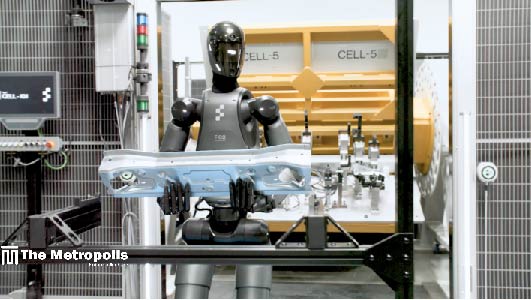California-based robotics company Figure AI has announced plans to produce 100,000 humanoid robots over the next four years, leveraging AI technology and partnerships with BMW, OpenAI, and Microsoft. In a recent LinkedIn post, Figure AI CEO Brett Adcock shared the company’s strategy, emphasizing the deployment of robots capable of performing complex tasks in real-world environments.
Adcock highlighted the company’s approach of working with a select number of major clients instead of aiming for broad market penetration. “Early on, it’s more efficient for us to grow vertically within a few clients than to spread out across many,” Adcock remarked.
One of Figure AI’s major clients is BMW, marking the first instance of the German automotive giant integrating humanoid robots into its production process. According to the official BMW Group website, trials have been conducted with Figure AI’s ‘Figure 02’ robot, tested in real-world manufacturing environments.
“Through early test operations, we are now determining potential applications for humanoid robots in production. We want to support this technology from development through to industrialization,” stated Milan Nedeljković, BMW AG Board Member for Production.
During the trials, the ‘Figure 02’ robot successfully inserted sheet metal parts into specialized fixtures, assisting in the car body assembly process, according to BMW.
Figure AI’s second major client remains unnamed, though Adcock described it as “one of the biggest US companies,” with the potential for large-scale deployments that could reduce production costs and accelerate AI-driven improvements. “Between both customers, we believe there is a path to 100,000 robots over the next four years,” Adcock explained.
Figure AI’s humanoid robots, including the ‘Figure 01’ and ‘Figure 02’ models, are designed for commercial and industrial uses. While earlier versions had limitations in speed and dexterity, recent improvements have enhanced their capabilities, as noted in a recent Forbes article.
The ‘Figure 02’ model, for example, moves at a pace of 1.2 meters per second (about 2.68 miles per hour), close to an average human walking speed. The company is also working on the next-generation Figure 03, which is expected to bring further performance upgrades.
Figure AI’s entry into the humanoid robotics market puts it in competition with major players like Tesla, Agility Robotics, and Unitree. While the US continues to lead in robotics innovation, China is emerging as a strong competitor, with eight of the world’s top 16 humanoid robotics companies based there, according to Forbes.
Humanoid robots have potential applications extending beyond manufacturing, including logistics, healthcare, and even domestic use. While Figure AI has long-term goals for both commercial and consumer markets, its immediate focus is on industrial deployments.



